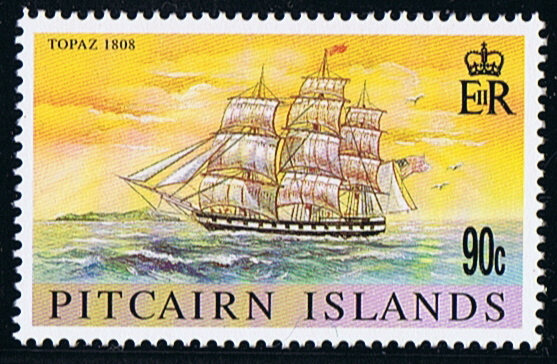
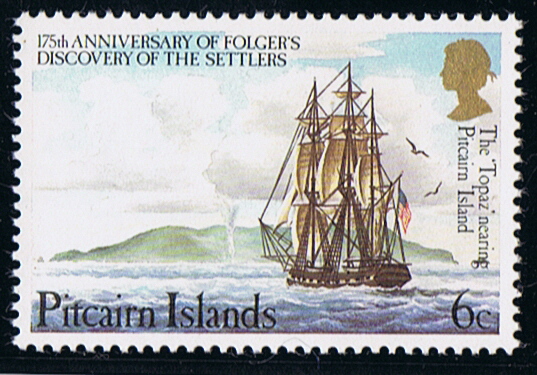
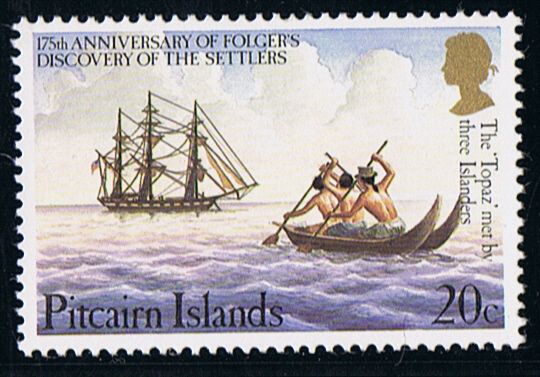
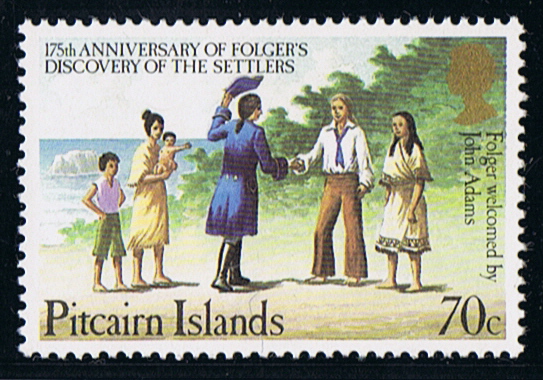
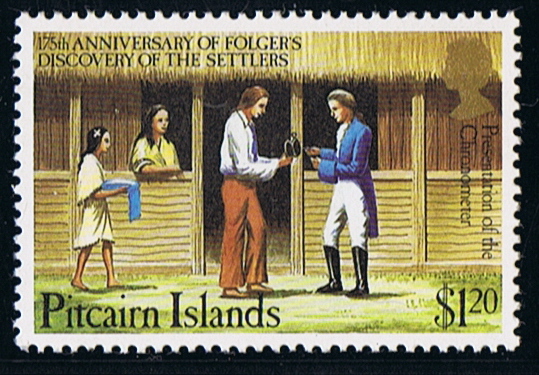
Built as a wooden ship in 1805 at Scituate, Mass. USA.
1805 Is her tonnage given as 385 ton, dim. 29.3 x 14.7ft.
Owned by Pachal P. Pope of Boston (other sources give Boardman & Pope.) and six others including Capt. Folger.
Ship rigged, two decks, three masts, square stern and a billet figure-head.
Registered at Boston, Mass. USA.
05 April 1807 she left Boston under command of Capt Mayhew Folger, for a voyage to catch seals, first she headed for the Cape Verde Islands for salt, and most probably some crew were also taken.
From the Cape Verde she sailed for Trinidad Island, Brazil, before she sailed to more southerly waters, south of Cape of Good Hope.
Four months after she left Trinidad she sighted the Kerguelen Island but due to heavy weather and bad visibility not a landing was carried out.
He sailed to Vanderman Island, Tasmania and anchored in Adventure Bay, looking for fresh water and firewood.
In this bay they met the British warship HMS PORPOISE, and together both ships sailed to Hobart Town, Tasmania.
25 October 1807 both ships approached the Derwent River, and dropt anchor in front of Hobart Town.
She was the second American ship what made a call at Hobart Town flying the American flag.
Capt Folger paid a courtesy visit to Lieutenant-Governor Colonel David Collins; he sold 800 gallon rum and 150 gallon gin to the crew of the HMS PORPOISE, most probably bought at Trinidad.
03 November she left bound for the Chatham Islands, where they arrived on 20 November there.
The Chatham is a group of island in a position 536 miles east of New Zealand. When he arrived they saw smoke of many fires, Folger did believe that the islands were uninhabited and he was surprised to see the smoke of the fires, at that time the Maoris where know as cannibals and he was afraid to make a landing.
23 November at 01.00 pm some crew landed on a large rock near Ragged Point, where 77 seals were killed and brought on board.
The next day 20 men of the crew landed, and the next day he wrote in his journal, only 600 seals were killed in these days.
The next day his crew landed on the Four Brothers, but not any seal was found; only they found some eggs and catch some nice fish. After the men were back on board, she left the Chatham Islands and headed for Antipodes Islands, where she arrived 17 December.
On arrival there they found out that there were already two camps with sealers ashore, and one group which had stayed there for four months had killed only 4000 seals.
After this news, Captain Folger set course with the TOPAZ for the Bristow Island a group of island 16 months before discovered by Capt. Abraham Bristow of the whaler OCEAN from owner Enderby. He discovered this group on 18 August 1806 and named the group the Lord Auckland’s Group.
Capt. Folger could not find the islands, and on 04 January 1808 he was again in the waters off the Chatham Islands.
He set then a south easterly course, and after weeks of not seeing anything except water, it got also colder but new islands or coasts were not discovered for the hunt on seals. And in need for drinking water he bore away for warmer waters. His intention was to search for an island that had been reported by Captain Carteret of HMS SWALLOW and named Pitcairn Island. It had not been sighted again, after searching in the latitude given for the island he did not find anything and bore away, later he sighted high land where no land was given on the charts of that period.
06 February 1808 he dropped anchor off Pitcairn, and two boats were launched to make a landing on the island in search for seals.
Then see http://library.puc.edu:80/pitcairn/pitc ... dia2.shtml
On 06 February 1808 his entry in the log book read:
At ½ past 1 pm saw land bearing SW by W½ steared for the land…. At 2 am the isle bore south 2 leagues distance. Lay off till daylight. At 06 am put off two boats to explore the land and look for seals.
On approaching the shore saw a smoke on the land at which I was very surprised it (Pitcairn) being represented by Captain Carteret as destitute of inhabitants, on approaching still more the land – I discovered a boat paddling towards me with three men in her.
The boat was a Tahitian-style canoe and the dark-skinned “natives” hailed the captain in English.
Who are you?
This is the ship TOPAZ of the United States of America; I am the master, Captain Mayhem Folger, and American.
“You are an American?” “You come from America?” “Where is America?” “Is it in Ireland?”
Folger was too taken aback by the “natives” speaking English to answer. Instead he asked:
“Who are you?”
“We are Englishmen.”
“Where were you born?”
“On the island which you can see.”
“How can you be Englishmen if you were born on that island?”
“We are Englishmen because our father is an Englishman.”
“Who is your father?”
“Aleck” (referring to Alexander Smith whose real name was John Adams, but who on the island was known as Aleck).
“Who is Aleck?”
“Don’t you know Aleck?”
“How sold I know Aleck?”
“Well then, do you know Captain Bligh of the BOUNTY?”
All seafaring men knew about the BOUNTY, about the mutiny, and about Bligh’s open-boat voyage. But no one in the world knew what had happened to Christian and the mutineers who had followed him in his quest for an island of refuge.
Imagine then the feelings that must have possessed Captain Folger when he realized that he was the first person in the world to find the hide-out of the mutineers of the BOUNTY! At the moment he did not know that all of them had died except one. He did not know whether he was in a dangerous situation or not. But the lads in the outrigger seemed so friendly and his curiosity overcame him. He told the youngsters in the canoe to ask “Aleck” to come on board.
The canoe went ashore, but soon returned without an extra passenger. Folger shouted:
“Where is Aleck?”
“Aleck does not want to come on board!”
No wonder. Folger immediately understood why “Aleck” would not want to come on board: he was afraid he would be arrested and taken to England to be hanged. But the youngsters in the canoe had an invitation.
“You are welcome to come ashore, Sir. Aleck and the women have prepared a meal for you.”
Folger was somewhat apprehensive himself, but again his curiosity won out. He remembered how often he and his friend, Amasa Deslano, had discussed the mystery of the missing mutineers of the BOUNTY. He decided to go ashore. His log reads as follows.
I went on shore and found there an Englishman by the name of Alexander Smith, the only person remaining out of the nine that escaped on board the ship BOUNTY, Captain Bligh, under the command of the archmutineer Christian. Smith informed me that after putting Captain Bligh in the longboat and sending her adrift, their commander Christian – proceeded to Otaheiti, then all the mutineers chose to stop except Christian, himself and seven others, they all took wives at Otaheiti and six as servants and proceeded to Pitcairn’s Island where they landed all their goods and “chattels”, ran the ship BOUNTY on shore and broke her up, which took place as near as he could recollect in 1790 – soon after which one of their party ran mad and drowned himself another died with a fever, and after they had remained about four years on the island their men servants rose upon and killed six of them. Leaving only Smith and he desperately wounded with a pistol ball in his neck, however he and the widows of the deceased man arose and put all the men servants to death which left him the only surviving man on the island with eight or nine women and several small children…. He immediately went to work tilling the ground so that it now produces plenty for them all and the(re) he lives very comfortably as Commander in Chief of Pitcairn’s Island, all the children of the deceased mutineers speak tolerable English some of them are grown to the size of men and women, and whatever may have been the errors or crimes of Smith the mutineer in times back, he is at present in my opinion a worthy man and may be useful to navigators who traverse this immense ocean, such the history of Christian and his associates.
The garbled history in this account must be due partly to Adams hiding the truth (he was to tell widely differing stories to subsequent visiting sea captains) and partly to Folger’s own distortions of memory.
Adams was understandably reluctant to talk about the mutiny. But he was eager to find out what had happened in England since he left it more than twenty years ago. And Captain Folger told him about the important changes in Europe over the two last decades: the French Revolution, Napoleon’s rise to power, and the tremendous and protracted war against France. When he came to describe England’s glorious victory in the Battle of Trafalgar in 1805, Adams rose and swung his hat three times over his head and called out “Old England forever? Huzzah.
Unfortunately Folger remained at Pitcairn for only 10 hours. As parting gift, Adams presented him with the BOUNTY’s azimuth compass and with the Kendall chronometer which had served Bligh – and later Christian – so well. (An often repeated, but false, claim in the BOUNTY literature is that this chronometer had been used by Captain Cook in the RESOLUTION on the third voyage. The fact is that Cook’s chronometer was the only one today referred to as K (Kendall) 1: the BOUNTY chronometer was K2.
Folger sailed eastward to Juan Fernandez (Robinson Crusoe’s Island) where the compass and the chronometer were both, for some unexplained reason, confiscated by the Spanish Governor.
The Spanish governor on Juan Fernandez kept Folger and his crew in jail until some months later a new governor arrived and set the Americans free.
When Folger finally arrived in Valparaiso, he reported his momentous discovery to Lieutenant William Fitzmaurice of the Royal Navy who was serving on the naval station in Chile. Fitzmaurice forwarded this report, together with an extract of the log of the TOPAZ, to the commander of the British naval station in Brazil on 10 October 1808.
The British Admiralty received the report on 14 May 1809.
After the TOPAZ sailed from Valpairaiso, she sailed around Cap Horn to Boston
After the TOPAZ arrived at Boston in the end of 1808, is it not clear what happened with the TOPAZ thereafter, there was a TOPAZ later used in the packet service between the U.K. and Boston, but I am not sure if she is the same vessel.
Pitcairn 1983 6c and 20c sg 238/9, 1999 90c sg 550
Sources: Whalers out of van Diemen’s Land by Harry O’May. The Sea Hunters by Stackpole. Some web-sites,
